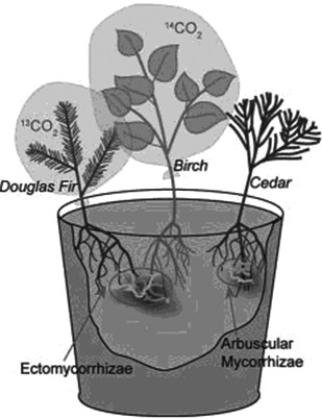Suzanne Simard and colleagues knew that the same mycorrhizal fungal species could colonise multiple types of trees. They wondered if the same fungal individual would colonise different trees, forming an underground network that potentially could transport carbon and nutrients from one tree to another (S. Simard et al. 1997. Net transfer of carbon between mycorrhizal tree species in the field. Nature 388:579-82) .
Pots containing seedlings of three different tree species were set up and grown under natural conditions for three years (Fig.A) . Two of the three species (Douglas fir, birch) could form ectomycorrhizal connections with the same fungal species, but the third species (cedar) could not form an ectomycorrhizal connection with the fungal species. In some of the pots, the researchers placed airtight bags over the Douglas fir and birch seedlings and injected carbon dioxide made from carbon-13 into the bags with the Douglas fir and carbon dioxide made from carbon-14 into the bags with the birch. (13C and 14C are different isotopes of carbon that can be detected and measured by researchers.) As the seedlings photosynthesised, the carbon dioxide was converted into sugars that could be tracked and measured by the researchers. The researchers measured whether the sugars in each plant contained only the carbon isotope that was in the air of their plastic bag or also the carbon isotope from the air around the other plant.
Figure A
-Referring to Simard et al. (1997) , which design element is the control in this experiment and why?
A) the bags over the seedlings to contain the different types of carbon dioxide
B) the fact that all the seedlings are different species
C) the cedar seedling, because it is not bagged
D) the cedar seedling, because it does not form ectomycorrhizal connections with the tested fungus
Correct Answer:
Verified
Q5: Fungi have an extremely high surface-to-volume ratio.
Q6: Some fungal species live in plants and
Q17: What do fungi and arthropods have in
Q18: Suzanne Simard and colleagues knew that the
Q19: Suzanne Simard and colleagues knew that the
Q22: You observe the gametes of a fungal
Q23: In most fungi, karyogamy does not immediately
Q24: Early fungi probably formed mutualistic associations with
Q32: Why are mycorrhizal fungi superior to plants
Q38: Chitin is a long-chain polymer derived from
Unlock this Answer For Free Now!
View this answer and more for free by performing one of the following actions

Scan the QR code to install the App and get 2 free unlocks

Unlock quizzes for free by uploading documents